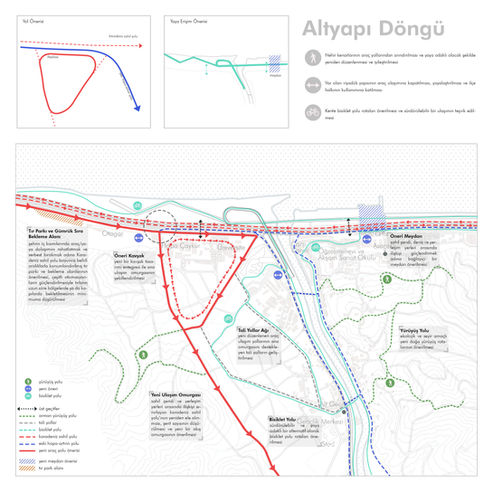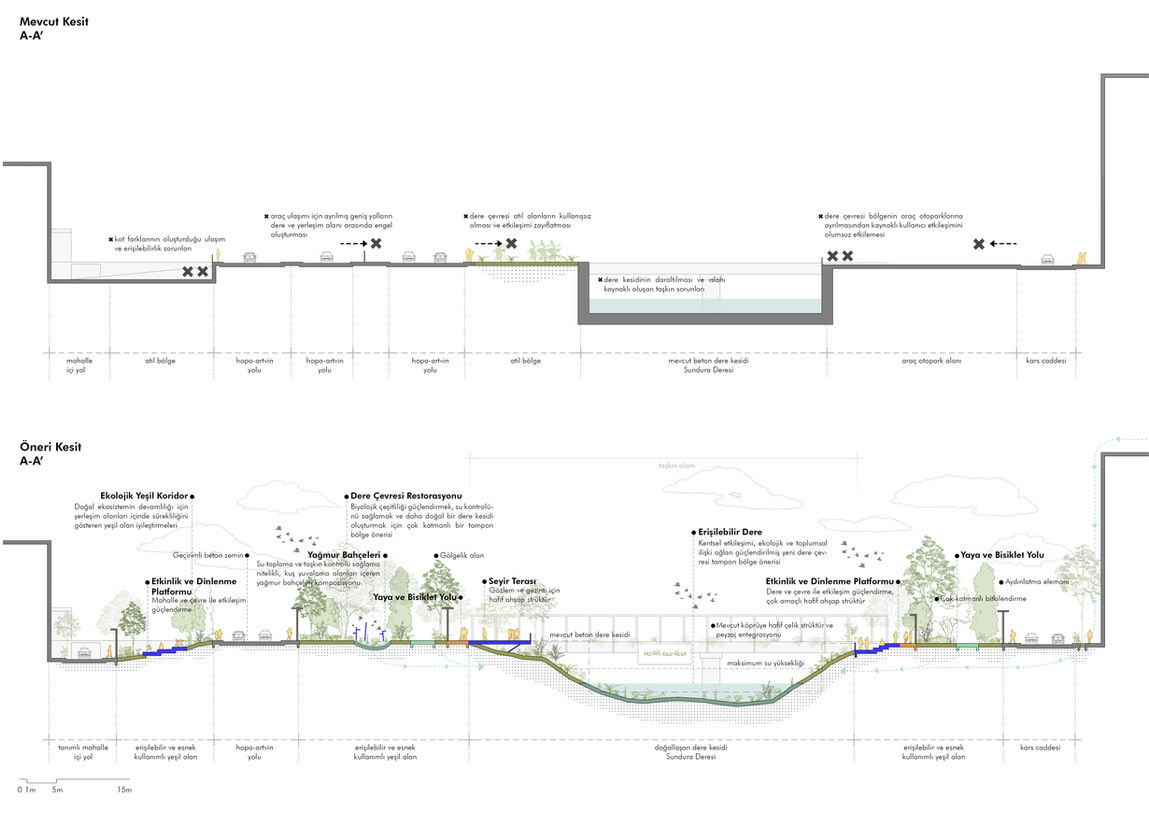Get in touch with us at info@atelierbirches.com

Hopa Urban Desing and City Centre
Award: 1st Prize
Beyond Reclamation: An Ecopolitical Imagination
Beyond Reclamation: An Ecopolitical Imagination
Toward a living shoreline beyond control and concrete.
Situated between the Kaçkar and Balıklı Mountains on the eastern edge of the Black Sea, Hopa is more than a town; it is a living memory shaped by water, forest, and social life unfolding along the shoreline. This project reclaims that memory, not through nostalgia, but through an ecological and political vision rooted in geography.
Rather than proposing more infrastructure, plazas, or neatly packaged recreational spaces, the project frames the future of Hopa around the idea of living with the coast. Spatial sketches, archival materials, and on-site readings reveal that public life in Hopa was never organised around a formal square, but rather emerged organically around the pier, the markets, and the rhythms of fishing and gathering.
Today, the town is threatened by aggressive land reclamation, transport-dominated planning, and ecological fragmentation. The systems, creeks, wetlands, groundwater, and rain that once sustained Hopa have been interrupted or erased. This project identifies the roots of these crises as political and economic, and positions Hopa as a terrain for ecological justice.
The design moves beyond conventional masterplanning. It offers multi-scalar strategies that integrate water cycles, biodiversity corridors, pedestrian access, and local participation. By restoring riverbeds, removing harmful viaducts, and redefining mobility around slowness and access, the project builds a continuous, living shoreline that reconnects Hopa’s neighbourhoods to its coast.
Rather than viewing the land as a resource to be controlled, the proposal embraces a Heideggerian ethic of dwelling, a way of being with the earth, not over it. This approach reframes planning as care: for water, for community, for every living and non-living presence in the landscape.
Ultimately, this is not only a spatial proposal, it is an ecopolitical manifesto. Hopa becomes a prototype for coastal towns across the Black Sea that seek to move beyond extraction and control, toward coexistence and resilience. The project asks: What if planning began not with construction, but with listening to water, memory, and the more than human world?
Podgorica Trade Fair and Congress Centre
Award: Honorable Mention
Project Type: Urban Design, Landscape, Sustainable Design, Biodiversity.
Location: Hopa, Artvin.
Scale: 500.000 m2
Year: 2025, Competition
Client: Municipality of Hopa
Design: Atelier Birches
Award: 1st Prize
Ecopolitical Groundworks: Rain, Resistance, and the Right to Stay
A spatial manifesto for Hopa—
This is not a master plan. It is a groundwork. A weaving together of spatial justice, ecological rhythm, and the right to stay. It asks: What does it mean to belong to a place under pressure? How can design protect not just land, but the relationships that make it meaningful?
In Hopa, the answer lies not in reclaiming territory, but in reclaiming the ability to live with it through water, memory, and resistance. The shoreline becomes not a margin, but a threshold. Not the end of the city, but its beginning.
It proposes parks that hold water, creeks that breathe again, and surfaces that absorb rather than repel. Hydrology becomes not an engineering challenge, but a political stance: to allow cycles to return, and with them, life.
Hopa’s landscape holds the traces of what has been slowly erased not only through planning and policy, but through the loss of daily, intimate geographies. The pier once gathered people through unspoken rituals: waiting for fishing boats, walking to the market, watching a film at Yıldız Cinema. Today, these practices are fractured by roads, barriers, and landfills. This project begins by reading the ground not as surface, but as archive, one that remembers through absence, water, and informal use.

Urbanism for All Species
Today, the town faces increasing floods, disconnected neighborhoods, disappearing creeks, and the loss of biodiversity. The construction of highways, viaducts, and filled shoreline areas has blocked natural water flows and created a fragmented urban structure. What used to be a walkable, social, and ecologically rich coastal town is now under pressure from a top-down urban model that prioritises speed, cars, and short-term growth.
This project proposes a shift. Instead of more reclamation, it suggests restoring natural water cycles, supporting biodiversity, and re-establishing the connection between people and the coast. It offers a series of urban design strategies that focus on soft infrastructure: permeable surfaces, widened riverbeds, stormwater parks, ecological bridges, and pedestrian networks that connect the mountain to the sea.
By removing harmful viaducts and transforming them into public walkways and ecological corridors, the proposal turns barriers into bridges. Flood zones are no longer seen as risks but as opportunities to create green areas that hold water and life. The shoreline is reimagined not as a limit to expand beyond, but as a living space to protect, share, and belong to.
This approach supports long-term urban sustainability by valuing slow mobility, local economies, ecological continuity, and community access to nature. It aims to make Hopa more resilient, not only to environmental challenges but also to the social and political forces that threaten its identity.
In doing so, the project invites a new way of planning, one that respects rain, remembers the past, and allows both humans and ecosystems to stay, grow, and thrive together.






Urban Design Strategy
We redefine Hopa’s shoreline as an ecologically resilient, socially inclusive, and spatially continuous public landscape.
-
Coastal Continuity
A seamless waterfront promenade establishes uninterrupted pedestrian and ecological flow across the site. Rain gardens, bioswales, and soft edges reinforce the landscape’s performative capacity along the Black Sea coast.
-
Reclaiming the Landing Stage
The historic landing stage and its surroundings are reimagined as a civic field; an open, adaptable, and porous coastal plaza that anchors local memory while opening up new public rituals.
-
Sundura River Integration
The design embraces the creek as a spatial and ecological asset. Green corridors and over-creek crossings reestablish connectivity between the town center and the shoreline, threading together Hopa’s fragmented edges.
-
Nature-Based Infrastructure
A green-blue infrastructure framework manages stormwater, mitigates coastal risks, and fosters biodiversity. Eco-buffers and planted trenches turn the waterfront into a resilient interface between land and sea.
-
Collective Use Anchors
Recreational zones, open lawns, and multi-use clearings create a social fabric along the coast. These spaces support seasonal and daily use, encouraging interaction across ages, rhythms, and communities.

Site Plan : 1/1000
Our proposal offers a network of spatial systems that integrate soft mobility, nature-based infrastructure, and modular public programs. A restructured shoreline profile enables uninterrupted pedestrian and bicycle movement, while bioswales, permeable grounds, and native planting improve climate resilience and hydrological performance.
Historical elements such as the landing stage are reactivated as collective gathering spaces. Fragmented urban fabrics disrupted by roads, infill zones, and obsolete infrastructure are reconnected through bridges, viaduct conversions, and a revived river corridor.
Rather than a singular object or gesture, the project unfolds as a set of performative terrains: civic platforms, ecological thresholds, market grounds, and shaded clearings. Each intervention responds to the site’s specific topography, heritage, and environmental dynamics transforming the coastline into a living, porous, and plural public space.



























































